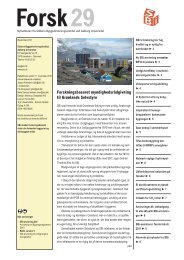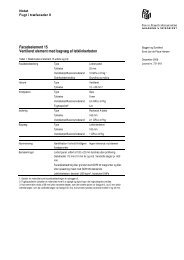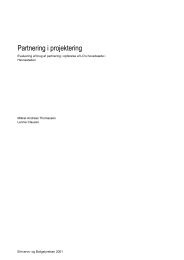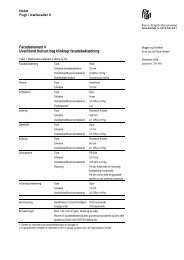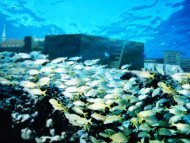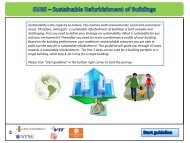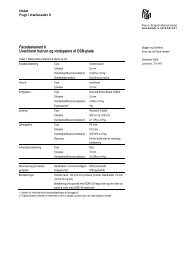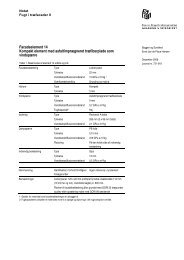Mould growth on building materials - Statens Byggeforskningsinstitut
Mould growth on building materials - Statens Byggeforskningsinstitut
Mould growth on building materials - Statens Byggeforskningsinstitut
You also want an ePaper? Increase the reach of your titles
YUMPU automatically turns print PDFs into web optimized ePapers that Google loves.
2.6.1.2 Gas chromatography<br />
As previously menti<strong>on</strong>ed, mycotoxins are generally not volatile and hence gas chromatographic<br />
detecti<strong>on</strong> of them will always have to face instability problems during injecti<strong>on</strong> and<br />
chromatography 344 . On the other hand capillary GC gives 10-100 times higher separati<strong>on</strong><br />
power 345 than LC (packed column) and runs very stable with flame i<strong>on</strong>isati<strong>on</strong>, electr<strong>on</strong> capture<br />
detecti<strong>on</strong> (ECD), and MS, which are significantly more sensitive than UV and refracti<strong>on</strong><br />
index detectors used in LC.<br />
Almost all GC methods for mycotoxins start with derivatisati<strong>on</strong> of free OH and N-H groups 346<br />
to decrease the thermal lability. Acid groups are usually methylated, and alcohol groups are<br />
reacted to their TMS ether or esterficied to their acetyl or pentafluoropropi<strong>on</strong>yl esters 340,344 .<br />
GC methods <strong>on</strong> most mycotoxins have been published, inter alia AFB1 and ST 346 , Alternaria<br />
mycotoxins 347 , penicillic acid 348 , patulin 349 , the backb<strong>on</strong>e of the AAL toxins and the fum<strong>on</strong>isins<br />
350 , and especially the TR 340 . The latter, is the <strong>on</strong>ly group where GC-MS or GC-ECD has<br />
been the primary analytical method. 351-365 .<br />
2.6.1.2.1 GC-MS for trichothecenes<br />
The use of MS detecti<strong>on</strong> of the pentafluoropropi<strong>on</strong>yl- (PFP) or heptafluorobuturyl (HPB) esters<br />
will give the highest sensitivity if the MS has a mass range > m/z 800 340 . These derivatives<br />
can be formed by the imidazoles PFPI and HFBI respectively or acid anhydrides PFPA<br />
and HFBA respectively, although the latter needs a nucleophilic catalyst such as triethylamine,<br />
dimethylaminopyridin or imidazole 340 . Unfortunately the TB react slowly with both types<br />
of reagents and can undergo isomerisati<strong>on</strong> giving more than <strong>on</strong>e peak 352 . The fluorinated<br />
derivatives can be detected selectively to very low levels using negative i<strong>on</strong> chemical i<strong>on</strong>isati<strong>on</strong><br />
(NICI)-MS or ECD, but also positive electr<strong>on</strong> impact i<strong>on</strong>isati<strong>on</strong> (EI + )-MS or positive<br />
chemical i<strong>on</strong>isati<strong>on</strong> (PCI)-MS can been used 360,366,367 .<br />
TR lacking free OH groups cannot be detected using NICI and ECD unless they are hydrolysed<br />
to their parent alcohols prior to derivatisati<strong>on</strong> 353,360 .<br />
2.6.1.2.2 GC-MS for sterols<br />
GC-MS has also been used, usually based <strong>on</strong> an internal standard, such as cholesterol or<br />
dehydrocholesterol 335,368 , as a isotope substituted standard is not commercially available. Erg<br />
has usually been derivatised to its tertiary-butyldimethylsilyl or trimethylsilyl (TMS) ether to<br />
reduce decompositi<strong>on</strong> during injecti<strong>on</strong> and chromatography. On-column injecti<strong>on</strong> can also be<br />
used to further reduce decompositi<strong>on</strong> 330 , but this method requires cleaner samples and is not<br />
as robust as splitless injecti<strong>on</strong> 368 .<br />
2.6.1.3 High performance liquid chromatography<br />
Since the late 1980s and the start of the 1990s HPLC have been the most important analytical<br />
method for mycotoxins 337,369,370 .<br />
The success of HPLC compared with the other methods have several reas<strong>on</strong>s. Firstly the<br />
instruments have decreased in price as well as getting easier to maintain. They are easily<br />
automated and PCs can sample and do automated detecti<strong>on</strong> of target compounds. Many<br />
column <strong>materials</strong> are available from many different manufactures, and significantly larger<br />
samples can be injected than in a GC. More over samples do generally not demand derivatisati<strong>on</strong><br />
as GC does.<br />
From the mid 1990s the use of HPLC with MS detecti<strong>on</strong> employing atmospheric pressure<br />
i<strong>on</strong>isati<strong>on</strong> techniques (API) 371 such as electrospray 372 and atmospheric pressure chemical<br />
Page 26



